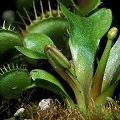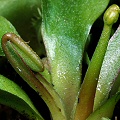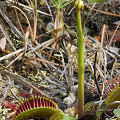Q: Should I let my Venus flytrap flower?

New flower stalk

Stalk detail

Flowering au natural
A: No!
That was easy, eh? Now for the why's.
The process of making flowers takes a great deal of the plant's
energy. After flowering,
a Venus flytrap will be sluggish for nearly an entire year. In the wild they get over
this slow period very quickly. But in cultivation, where the light, humidity, and other
conditions are rarely ideal, the plants may never escape this
weakened state. In fact, they may even die!
This is why, unless you are a very skilled flytrap grower or have spare plants to
risk, I advise you to trim those flower stalks off as soon as you can.
You can tell when your plant is
going to flower because a weird cylindrical stem (unlike a leaf) will start
growing out of the center of your plant. See the middle photograph to the right?
The young flower stalk is on the right, while a young leaf is on the left.
The flower stalk will get taller and taller, and
will eventually make rather unimpressive flowers.
When you remove the young flower stalk, the plant
may make more. Trim them off too!
Apparently, the previous paragraph is not clear enough for many of you. So let
me be extra specific! See the cylindrical (rod-shaped) stalk in the bottom picture
at the right? The one with the bud at the top? This is a flower stalk just
emerging. Cut it off at the base.
If you wait until the flower stalks are so tall the flower buds begin to enlarge (which happens at
about 10-20 cm (4-8 inches), you might as well let the plant flower--the
damage is done. What the heck, pollinate the plant and maybe you'll get seed.
Your flytrap is probably going to die, though, unless you are a pretty
skilled grower.
You will often hear people say that the whole thing about cutting off flowers is bogus, and
that their plants do just fine without the flower buds being removed. I think those people are
very good growers (by luck or by skill), but have forgotten what it was like to be a beginning grower.
Page citations: Rice, B.A., 2006a; personal observation.